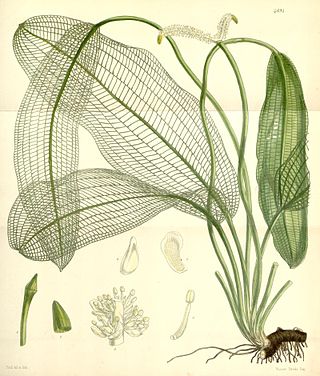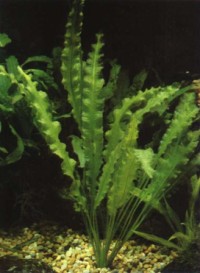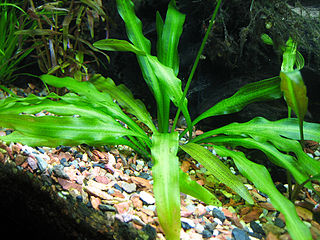
Pistacia is a genus of flowering plants in the cashew family, Anacardiaceae. It contains 10 to 20 species that are native to Africa and Eurasia from the Canary Islands, all of Africa, and southern Europe, warm and semidesert areas across Asia, and North America from Mexico to warm and semidesert United States, such as Texas or California.

Taxodium ascendens, also known as pond cypress, is a deciduous conifer of the genus Taxodium, native to North America. Many botanists treat it as a variety of bald cypress, Taxodium distichum rather than as a distinct species, but it differs in habitat, occurring mainly in still blackwater rivers, ponds and swamps without silt-rich flood deposits. It predominates in cypress dome habitats.

Aponogeton madagascariensis is commonly known as Madagascar laceleaf, lattice leaf or lace plant. It is an aquatic plant native to Madagascar, popularly sold for use in aquariums.

Calathea is a genus of flowering plants belonging to the family Marantaceae. They are commonly called calatheas or prayer plants. About 200 species formerly assigned to Calathea are now in the genus Goeppertia. Calathea currently contains around 60 species. Native to the tropical Americas, many of the species are popular as pot plants due to their decorative leaves and, in some species, colorful inflorescences. The young leaves and bracts can retain pools of water called phytotelmata, that provide habitat for many invertebrates.

The Aponogetonaceae are a family of flowering plants in the order Alismatales.

The harlequin rasbora is a small fish in the family Cyprinidae. The species became an instant favorite among aquarists after its introduction in the early 1900s and is the best known and most widely kept species among the rasboras. In 1935, an image of a trio of harlequin rasboras, stamped in 14k gold, would grace the cover of the first edition of William T. Innes's classic Exotic Aquarium Fishes and would remain so through all 19 editions.

Aponogeton distachyos or Aponogeton distachyum, also known as waterblommetjie, Cape-pondweed, water hawthorn, vleikos and Cape pond weed is an aquatic flowering plant.

Aponogeton crispus is an aquatic plant species.
Aponogeton azureus is a species of plant in the Aponogetonaceae family. It is endemic to Namibia. Its natural habitat is freshwater marshes. It is threatened by habitat loss.

Aponogeton ulvaceus is a submerged aquatic plant in the Aponogetonaceae family. It has a small cone shaped, slightly hairy rhizome about 30 mm in diameter. The leaf blades have a base that tapers gradually, pale green in colour, over 50 cm (20 in) long and 8 cm (3 in) broad, with a wavy margin on petioles of an equal length, and in appearance slightly translucent. A single bulb may produce up to forty leaves in good conditions. No floating leaves are formed. The yellow flowers are produced on one or two, and sometimes more, erect spikes.

Aponogeton undulatus is a species of aquatic plant, sometimes used in aquariums. Some taxonomists consider this should be under the name Aponogeton stachyosporus.
Aponogeton longiplumulosus is a submerged aquatic plant that is native to Madagascar. It possesses an elongated rhizome 2–3 cm in diameter. The leaves are an olive green-brown, 8 - 14 inches (20–35 cm) long and 2.5 inches (6 cm) broad, with a fluted margin and a petiole up to about 24 inches (60 cm) long. No floating leaves are formed. New leaf colour forms have been introduced recently. The flowers are a dark violet in colour.

Aponogeton rigidifolius is a species of freshwater plant native to Sri Lanka. In the wild it grows in deep water at temperatures of 68 to 77 °F in sandy soil with the water pH at 7.2.

Nymphaea nouchali, often known by its synonym Nymphaea stellata, or by common names blue lotus, star lotus, red water lily, dwarf aquarium lily, blue water lily, blue star water lily or manel flower, is a water lily of genus Nymphaea. It is native to southern and eastern parts of Asia, and is the national flower of Bangladesh and Sri Lanka. In Sanskrit, it is utpala. This species is usually considered to include the blue Egyptian lotus N. nouchali var. caerulea. In the past, taxonomic confusion has occurred, with the name Nymphaea nouchali incorrectly applied to Nymphaea pubescens.

Heinrich (Harry) Wilhelm Eduard van Bruggen was a Dutch amateur botanist.

Cape Lowland Freshwater Wetland is a critically endangered vegetation type of the Western Cape, South Africa.

Aponogeton lakhonensis is a species of an aquatic genus Aponogeton, itself the only genus in the Aponogetonaceae family. This species with a yellow-flowered single spike rising above the water, is found in ricefields, ponds and slow-moving streams of tropical and sub-tropical Asia. An outlier population occurs in Sulawesi, the main area of occurrence is from Thailand to Zhōngguó/China and Assam in India. It is more closely related to tropical Australian species of Aponogeton than it is to other Southeast Asian species. In Thailand the whole plant is eaten is salads, whereas Cambodians prefer the leaves alone served with fish sauce.

Aponogeton natans is a species of aquatic plant in the family Aponogetonaceae.















